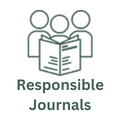Publishing Process
The evaluation process of articles in Perseitas consists of 4 steps: 1. Thematic evaluation, scientific quality, structure and citation standards. 2. Analysis of similarity with other publications. Peer review and, 4. Verdict. The evaluation process is described below:
1. Thematic evaluation, scientific quality, structure and citation standards: The review and initial selection of manuscripts is the responsibility of the journal's editorial team, which accepts or rejects the originals based on scientific quality, relevance to the journal's thematic axes, timeliness of the references, validity of the results and the criteria described in the authors' guide. If the manuscript does not meet the basic criteria of scientific quality or does not respond to the subject matter of the publication, it is returned to the author; if the formal or substantive presentation can be improved with minor changes, the author is asked to make the corrections and make a new submission within a time frame adjusted to the editing schedule; if the article meets the above conditions, the second stage of the evaluation process will begin.
2. Analysis of similarity with other publications: in order to identify if the articles are original and unpublished and to avoid possible copies and plagiarism, professional technology is used to compare manuscripts with others already disclosed by different digital media, including academic publications Crossref participants. The technological system generates a report and index of similarity; if the latter is greater than 25%, the article is discarded; If, on the other hand, the index is up to 25%, the article continues in the third stage of the process. From the report, errors are identified in the handling of citations and references, adequate use of primary sources and credibility of the information.
3. Peer evaluation: the articles are subject to peer evaluation under the double blind modality, that is, that the information of the authors for the reviewers is confidential, and vice versa; to this is added that among the latter, personal data and evaluative concepts are not disclosed. Once the evaluation of the article has begun, the authors undertake not to withdraw it until the end of the process.
Selection of evaluators: the journal has a database of academic researchers, national and international, with experience in the field of the humanities, in general, and in the philosophical and theological, in particular. For each article, two evaluators are assigned who comply with: having an academic level equal to or higher than that of the authors; not belong to the editorial committee or the scientist of the magazine or to the Luis Amigó Catholic University; If you are Colombian, you must be recognized as a researcher by Colciencias, otherwise, have a graduate degree or an H5 index greater than 2.
Review of the articles: the address of the journal gives the arbitrators the article accompanied by the guide for authors and an evaluation form in which the following formal and thematic elements are addressed:
- Relevance of the article according to the interests of the journal
- Correspondence of the title with the theme
- Validity of the subject
- Use of terms and concepts according to the discipline
- Relevance of graphs, tables and figures
- Appropriate use of citations and references
- Current references
- Novelty of work
- Theoretical-methodological rigor
- Text coherence
4. Verdict: the form closes with three alternative opinions: 1. "Published without modifications"; 2. If both reviewers consider that the article is "not published", the journal's management communicates the decision to the author and sends, as support, the result of the evaluations delivered by the referees. If both reviewers agree that the article is "published without modifications", the author is informed of the decision and the article is sent to the editing stage. If one evaluator considers that the article should be published without modifications and the other that it should be published with corrections, the author is informed of the changes to be implemented and the date by which he/she should send the document with the requested corrections. If one of the two evaluations qualifies the text as "not publishable", while the other favors it, the journal's management will appoint a third referee (maintaining the "double blind" modality) to settle the controversy. Once the third evaluation has been received, the author will be informed of the decision. In the event that controversies arise from the evaluators' opinions, these will be initially resolved by the editor, who will decide, based on the respective analyses, the convenience of publishing the manuscripts received. If necessary, in exceptional situations, the editorial committee will be contacted to resolve major controversies.
Rejection grounds are considered:
- The plagiarism and the autoplaggio, the adulteration, invention or falsification of data of the content and the author, and that the article is not unpublished and original.
- That the content of the texts does not have a level of originality equal to or greater than 75%.
- The existence of conflicts of interest.
- Failure to follow the guidelines for the authors.
- Writing in obscene, abusive, defamatory, abusive terms or in any way contrary to human dignity or the good name of a natural or legal person.
- The detection of data collected without the necessary permissions of natural or legal persons in these involved.
- Lack of theoretical support, lack of rigor in the presentation of the results derived from a research, doubtful exposure of data or results.
- Attempt against the ethical practices and good practices of the publication.
Among others that, according to the dynamics of the evaluation, attempt against the academic quality, the ethical practices or the good name of the journal and the Institutions that finance it.
Average response time (GMT-5):
-
Initial review: 15 working days
-
Peer review: 4 months
-
Adjustments after peer review: 15 working days
-
Proofreading: 2 months
-
Adjustments after proofreading: 1 month
-
Layout: 15 working days
The approximate turnaround time for the complete publication process of an article is 9 months.















